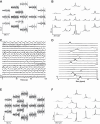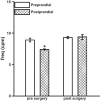Noninvasive biomagnetic detection of intestinal slow wave dysrhythmias in chronic mesenteric ischemia
- PMID: 25930082
- PMCID: PMC4491509
- DOI: 10.1152/ajpgi.00466.2014
Noninvasive biomagnetic detection of intestinal slow wave dysrhythmias in chronic mesenteric ischemia
Abstract
Chronic mesenteric ischemia (CMI) is a challenging clinical problem that is difficult to diagnose noninvasively. Diagnosis early in the disease process would enable life-saving early surgical intervention. Previous studies established that superconducting quantum interference device (SQUID) magnetometers detect the slow wave changes in the magnetoenterogram (MENG) noninvasively following induction of mesenteric ischemia in animal models. The purpose of this study was to assess functional physiological changes in the intestinal slow wave MENG of patients with chronic mesenteric ischemia. Pre- and postoperative studies were conducted on CMI patients using MENG and intraoperative recordings using invasive serosal electromyograms (EMG). Our preoperative MENG recordings showed that patients with CMI exhibited a significant decrease in intestinal slow wave frequency from 8.9 ± 0.3 cpm preprandial to 7.4 ± 0.1 cpm postprandial (P < 0.01) that was not observed in postoperative recordings (9.3 ± 0.2 cpm preprandial and 9.4 ± 0.4 cpm postprandial, P = 0.86). Intraoperative recording detected multiple frequencies from the ischemic portion of jejunum before revascularization, whereas normal serosal intestinal slow wave frequencies were observed after revascularization. The preoperative MENG data also showed signals with multiple frequencies suggestive of uncoupling and intestinal ischemia similar to intraoperative serosal EMG. Our results showed that multichannel MENG can identify intestinal slow wave dysrhythmias in CMI patients.
Trial registration: ClinicalTrials.gov NCT00179036.
Keywords: magnetoenterogram; mesenteric ischemia; slow wave.
Copyright © 2015 the American Physiological Society.
Figures





Similar articles
-
Magnetoenterography for the Detection of Partial Mesenteric Ischemia.J Surg Res. 2019 Jul;239:31-37. doi: 10.1016/j.jss.2019.01.034. Epub 2019 Feb 20. J Surg Res. 2019. PMID: 30782544 Free PMC article.
-
Noninvasive biomagnetic detection of isolated ischemic bowel segments.IEEE Trans Biomed Eng. 2013 Jun;60(6):1677-84. doi: 10.1109/TBME.2013.2240454. Epub 2013 Jan 15. IEEE Trans Biomed Eng. 2013. PMID: 23335661 Free PMC article.
-
Biomagnetic characterization of spatiotemporal parameters of the gastric slow wave.Neurogastroenterol Motil. 2006 Aug;18(8):619-31. doi: 10.1111/j.1365-2982.2006.00794.x. Neurogastroenterol Motil. 2006. PMID: 16918726
-
Diagnosis and treatment of chronic mesenteric ischemia: An update.Best Pract Res Clin Gastroenterol. 2017 Feb;31(1):49-57. doi: 10.1016/j.bpg.2017.01.003. Epub 2017 Feb 7. Best Pract Res Clin Gastroenterol. 2017. PMID: 28395788 Review.
-
Surgical and endovascular interventions for chronic mesenteric ischemia.J Cardiovasc Surg (Torino). 2015 Apr;56(2):299-307. Epub 2015 Feb 3. J Cardiovasc Surg (Torino). 2015. PMID: 25644829 Review.
Cited by
-
A Flexible Multiring Concentric Electrode for Non-Invasive Identification of Intestinal Slow Waves.Sensors (Basel). 2018 Jan 30;18(2):396. doi: 10.3390/s18020396. Sensors (Basel). 2018. PMID: 29385719 Free PMC article.
-
Magnetoenterography for the Detection of Partial Mesenteric Ischemia.J Surg Res. 2019 Jul;239:31-37. doi: 10.1016/j.jss.2019.01.034. Epub 2019 Feb 20. J Surg Res. 2019. PMID: 30782544 Free PMC article.
-
The virtual intestine: in silico modeling of small intestinal electrophysiology and motility and the applications.Wiley Interdiscip Rev Syst Biol Med. 2016 Jan-Feb;8(1):69-85. doi: 10.1002/wsbm.1324. Epub 2015 Nov 12. Wiley Interdiscip Rev Syst Biol Med. 2016. PMID: 26562482 Free PMC article. Review.
-
Electromechanical Response of Mesenteric Ischemia Defined Through Simultaneous High-Resolution Bioelectrical and Video Mapping.Ann Biomed Eng. 2024 Mar;52(3):588-599. doi: 10.1007/s10439-023-03404-w. Epub 2023 Nov 14. Ann Biomed Eng. 2024. PMID: 37962674
-
Progress in Mathematical Modeling of Gastrointestinal Slow Wave Abnormalities.Front Physiol. 2018 Jan 15;8:1136. doi: 10.3389/fphys.2017.01136. eCollection 2017. Front Physiol. 2018. PMID: 29379448 Free PMC article. Review.
References
-
- Belouchrani A, AbedMeraim K, Cardoso JF, Moulines E. A blind source separation technique using second-order statistics. IEEE Trans Signal Process 45: 434–444, 1997.
-
- Bradshaw LA, Erickson JR, Chung E, Richards WO. Gastroparesis alters magnetogastrogram propagation patterns. Neurogastroenterol Motil 23: 7–7, 2011.
-
- Bradshaw LA, Irimia A, Sims JA, Gallucci MR, Palmer RL, Richards WO. Biomagnetic characterization of spatiotemporal parameters of the gastric slow wave. Neurogastroenterol Motil 18: 619–631, 2006. - PubMed
Publication types
MeSH terms
Associated data
Grants and funding
LinkOut - more resources
Full Text Sources
Other Literature Sources
Medical

